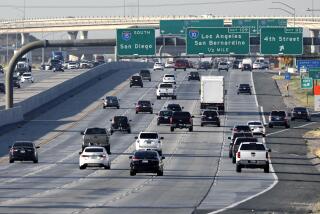Trafficking in Silly Studies
- Share via
You might want to take this page along on your morning drive to work today. According to new documentation, you’ll have time in the car to read during motionless pauses on L.A.’s reputedly clogged freeways. Like most Angelenos, we couldn’t really be sure that L.A. had severe traffic congestion. It does seem that way every single weekday morning and afternoon and early evening and weekend afternoons and early evenings in sun and rain. And holiday eves, holiday mornings and the last night of a holiday in winter, spring, summer and fall. But we couldn’t be sure until the American Highway Users Alliance spent an undisclosed sum to study national highway congestion.
The alliance’s timely revelation that U.S. traffic is worsening, especially in L.A., confirms the uselessness of endless studies that confirm the worst without actually making improvements. The nonprofit highway advocacy group uses calculations involving vehicles and wasted hours to concoct one of those top 10 lists increasingly popular among Americans because they’re simple. The group said that, yes, L.A. and many other areas had way too many people in the same place trying to go somewhere else at the same time. This startling news happened to emerge during Washington hearings on transportation spending by many Congress members who get driven to work. Among remedies, the alliance wants more highway construction, which might benefit drivers and, oh, also alliance members.
Thank goodness for such numbers though, confirming the obvious with a precision and certainty that come from knowing no one else is counting. We learned, for instance, that the L.A. area had only five of America’s 15 worst intersections, including a new No. 1, the 405/101 freeway interchange. We learned that 318,000 daily drivers there -- or maybe 350,000 by now -- were delayed 17 minutes and 30 seconds by congestion. (When did they study this place, 5 a.m. Sundays?) We learned the census of overworked bottlenecks (at least 700,000 delay hours a year) had in just five years gone from 167 to 233 in 33 states and Washington, D.C.
A highway alliance official sees hope. No, not a missile strike on traffic ahead. But an aggressive nationwide assault on choke points using imaginative and, well, yes, expensive concrete amendments and reconstructions. The study points to Albuquerque, where such work on the I-40/I-25 interchange pushed it out of the top 15, saving drivers 15 million hours a year. That’s a long time to be anywhere, let alone Albuquerque.
The study predicted that such planned but not yet funded improvements at L.A.’s 405/101 interchange would cut delays by 80% in 20 years. That’s an even longer time to wait in your car. But as always, experts are willing for us to make that investment in their future. Maybe best this morning to bring along “War and Peace” too.


